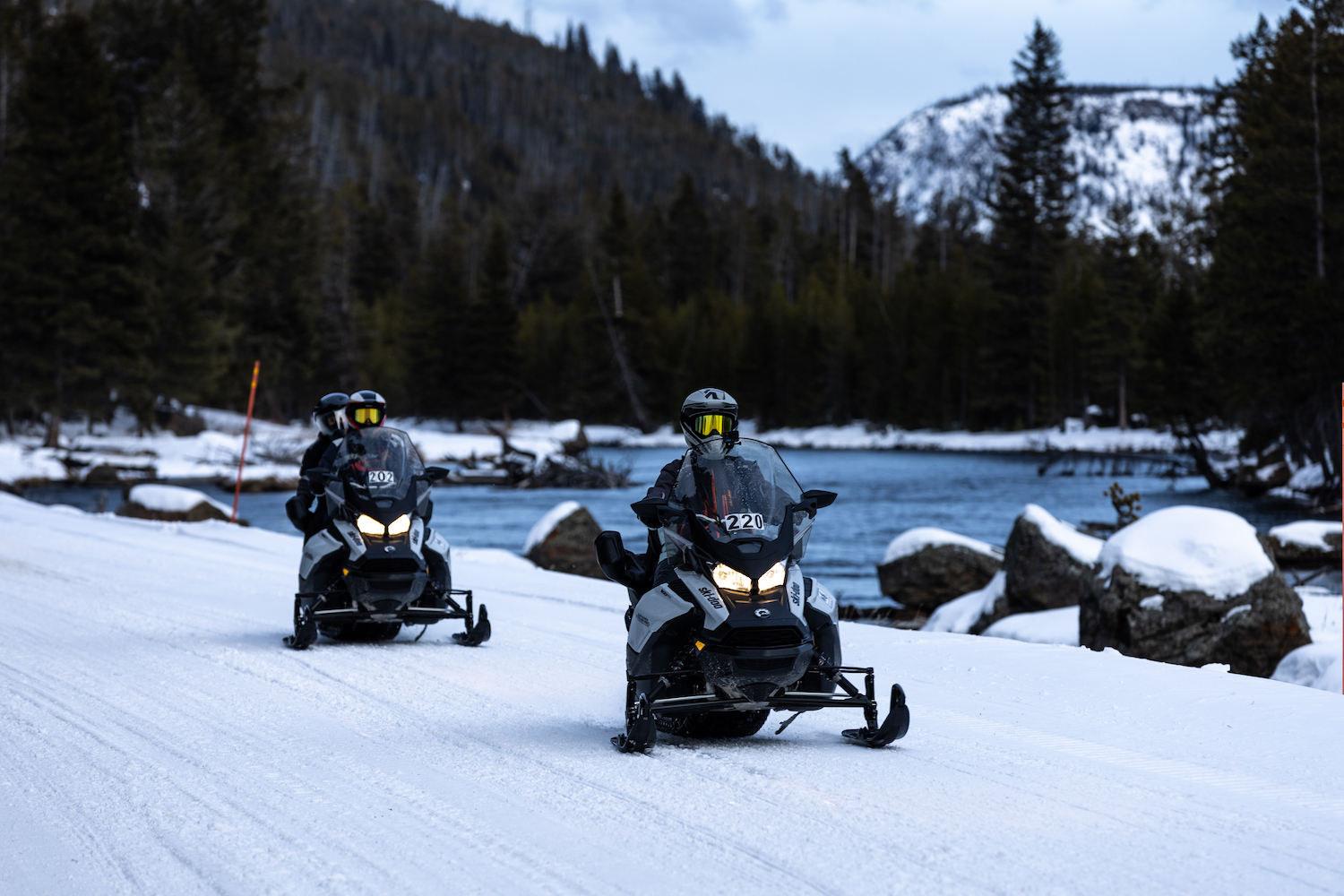

Replete with stunning hydrothermal and geologic features and thriving wildlife across 2.2 million acres, Yellowstone National Park is a national treasure. It’s also America’s first national park; former president Ulysses S. Grant made it official on March 1, 1872.
The national park maintains its beauty with a stringent set of environmental regulations that places the welfare of the park front and center. For example, during the winter months only certain kinds of vehicles and snowmobiles are allowed on the groomed trails, and they must meet the park’s Best Available Technology (BAT) standard for emissions. Only one snowmobile brand currently meets the criteria: Ski-Doo.
Snowmobile restrictions and regulations in Yellowstone
In 2023, Yellowstone National Park attracted 4.5 million visitors. Summer is the busiest time for Yellowstone, when kids are out of school and families are taking road trips across the country. Winter, however, is more tranquil and quieter. The bears are hibernating, the skies alternate between gray and a surreally saturated blue, and snow blankets the park with perfect crystalline snowflakes.
To navigate the trails once the snow falls, a limited number of snowmobiles and snowcoaches (vans or other vehicles fitted with giant snow tires) are allowed to operate inside the park. Snowmobiles were first permitted inside the gates in 1963 to boost winter attendance, as visitors could see more of the park than they could on foot or cross-country skis; the machines also enabled those with physical limitations. That went on until 1997, when animal rights organization Fund for Animals filed a lawsuit to ban snow grooming on paved roads in the park. Since snowmobiles were only permitted on groomed roads, the ban would have effectively eliminated snowmobile use as well.
[Related: There’s more magma under Yellowstone than we thought—but don’t panic]
Ultimately, snowmobiles remained, but with new safeguards in place for the Yellowstone ecosystem. Through that process, the national park service learned about new emissions technology offered in four-stroke snowmobile engines that decreased carbon emissions by more than 70 percent and decreased sound levels by about half.
As a result, updated regulations today state that snowmobiles entering the park must operate at or below 67 dBA (the measurement of sound levels) and must be certified for certain emissions levels. According to the National Park Service, a snowmobile “will be certified for six consecutive winter seasons following its manufacture or until the snowmobile travels 6,000 miles, whichever occurs later, and model year 2015-2017 snowmobiles must have less than 6,000 miles on the odometer to be approved.”

Ski-Doo’s approved-for-Yellowstone snowmobiles employ a four-stroke engine, which is more efficient and emits fewer toxic fumes than the two-stroke engines offered in other snow machines. The company’s ACE (advanced combustion efficiency) engines are designed with a square bore and stroke in a spherical combustion chamber and tuned to use less fuel to create power. Thus, fewer emissions. YouTube channel driving 4 answers does a great job explaining the difference between two- and four-stroke engines and how they work.
Of the two Ski-Doo engine configurations allowed at Yellowstone, the 600 ACE is the most fuel efficient with a rating of 28 miles per gallon at 60 horsepower, while the 900 ACE is good for 90 horsepower and gets 21.8 miles per gallon. These are off-the-shelf Ski-Doo engines that anyone can purchase, not just those traveling through Yellowstone National Park.
“From the get-go, [the ACE engines] were designed to be efficient,” says Steve Cowing from Bombardier Recreational Products (BRP), the company that owns Ski-Doo. “That includes the sizing of the valve, the stroke, the oil pump, and all the tiny little details.”
The future of electric snowmobiles
Ski-Doo’s parent company is aiming for all of its facilities to be carbon neutral by 2030 and for 50 percent of its products to be electric by 2035. Ski-Doo introduced two all-electric sleds last year, but it’s careful to note that they include limited range and are designed for short distances. Range anxiety is the same issue auto manufacturers face as infrastructure ramps up, Cowing says.
Currently, the electric snowmobile can’t get from West Yellowstone to Old Faithful and back on one charge, so it’s a different experience. And for someone looking to explore as much of Yellowstone’s natural splendor as possible, it’s much less satisfying.
So far, customers who have tested out the new electric sleds are impressed with the performance and power. It’s only the range that’s holding them back, and the brand isn’t anywhere near giving up on electric power.
“We need to be cleaner and quieter,” says BRP product development manager Frederic Desjardins. “The social perception of our industry is very important to us.”

Snowmobiling through the park allows visitors to see bison, coyotes, fowl, and maybe even wolves from a safe distance, and guides explain the rules of engagement explicitly before starting any tour. Wildlife is to be left alone and never approached for the well-being of both animals and humans.
Viewing the park from the seat of a snowmobile with heated seats and handlebars is a fun way to see it all within the parameters of safety and ecology, and manufacturers and tour guides are keen to stay within the lines. The area around Yellowstone, including scores of snowmobile guides, hotels, restaurants, and other hospitality depend on the industry to keep up with the standards and keep the park snowmobile-friendly. At the same time, it’s critical that manufacturers keep improving. Desjardin says each snowmobiler he knows loves nature; it’s one thing they have in common with the people who like to walk in the park.
“Snowmobilers see more nature in one day than most people see in one season or even three seasons,” says Cowing, a snowmobiling enthusiast and 22-year veteran of the industry. “People who live in West Yellowstone and in these parks understand it really well. They really are stewards of the land.”
Correction: The original version of this article incorrectly stated the date Yellowstone was made a national park.
